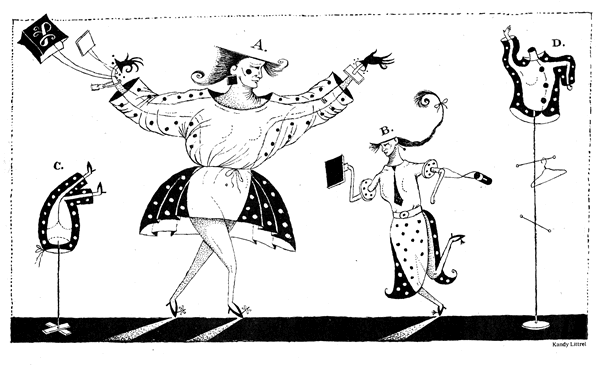Laura Marginata

Well, ladies, looks like it’s time for the annual fashion skirmish. Just as we finish fending off miniskirts, we’re facing another designer attack. This one’s a frontal assault.
Everybody knows about the deleterious consequences of a ripple effect. Now, thanks to the couture czars, we’ve got the nipple effect—see-through blouses and racy peek-a-boo garb meant to be worn in public by (you guessed it) us. The comment usually heard at times like this is: “Nobody’s forcing you to wear it.” If only it were that simple.
Can women escape a fashion trend they dislike? Yes and no. Yes, if enough women refuse to buy this gauzy merchandise, the trend is eventually doomed. Eventually. That’s the problem. Waiting for a trend like this to die is, well, sheer hell.
Fashion industry types know that women are caught in their clutches for at least a few months. Proclaims Elle magazine, “Like it or not, sheer is here.” Like it or not, you’re stuck—hunting through racks of see-through clothes when what you want and need is something opaque.
We’re also forced to watch other women parading around in this outrageous apparel. We see them showing their wares every time we glance at a magazine rack; their thinly veiled chests peer out from the pages of The New York Times Magazine. To our dismay, they will appear on billboards and in advertisements in the papers we read every day.
To say that each woman represents us all is doubtless an overstatement. But, just as the image of Pakistan’s Benazir Bhutto or the French author Marguerite Yourcenar shapes the world’s thinking about women’s role and potential, so do images of women in brazen attire.
When women don transparent garb, they feed the stereotype that we’re all merely seductresses. The rest of us must prove once again that women deserve to be taken seriously. A woman who deploys her breasts instead of her intelligence, wit, charm, etc., has opted for the least imaginative and most desperate way to get attention.
The February issue of Elle carries some telling pictures about the Arrival of Sheer. The way the photos are cropped, all but one of the models appear either headless or with the noggin lopped off right where the brain should be. The breasts occupy center stage on every page.
Imagine heading to work in a transparent blouse or one of the “sexy, high-powered” suits slashed from hem to waist to neck. The “power” of these clothes resides in the fact that they’re hardly clothes at all. They are lingerie masquerading as day wear.
Has anyone considered the nipple effect’s ramifications? Productivity will bump and grind to a halt as men spend the day staring at women’s gauze-wrapped bodies, or averting their eyes, or pretending to avert their eyes and peeking every chance they get. These garments seem designed specifically to provoke—they certainly don’t afford warmth.
Fashion articles claim these clothes are for well-toned women with nothing to hide. Some publications not only urge women to buy sheer clothing but to get a mammary overhaul to make themselves fit for visual consumption. Prime candidates for repair work: anyone who has experienced the vicissitudes of pregnancy, breast feeding, aging, or life with ample breasts.
Promoting this tripe, Elle magazine theorizes that, during trying times, women bare their breasts to nourish—at least figuratively—their nation. Sure.
Maybe there should be a law that designers must strut down the runway in the clothing they want to pawn off on us. If Yves Saint Laurent and others had to wear sheer chiffon pants with nothing underneath they might have second thoughts about thrusting such “chic” upon women.
Why must we buck one ridiculous fashion trend after another? While some of us don’t mind being labeled odd, provincial, close-minded, or even threatening because of our unwillingness to conform, resisting drains us emotionally and diverts our energy and brain power.
What say we declare the nipple effect dead on arrival? Why not agree to reveal our ideas and souls rather than our flesh? Enough of this grin-and-bare-it business. It’s nothing but sheer nonsense.
This essay appeared in the New York Times (March 18, 1989). Illustration © 1989 by Kandy Littrel. Reprinted with permission of the artist.

